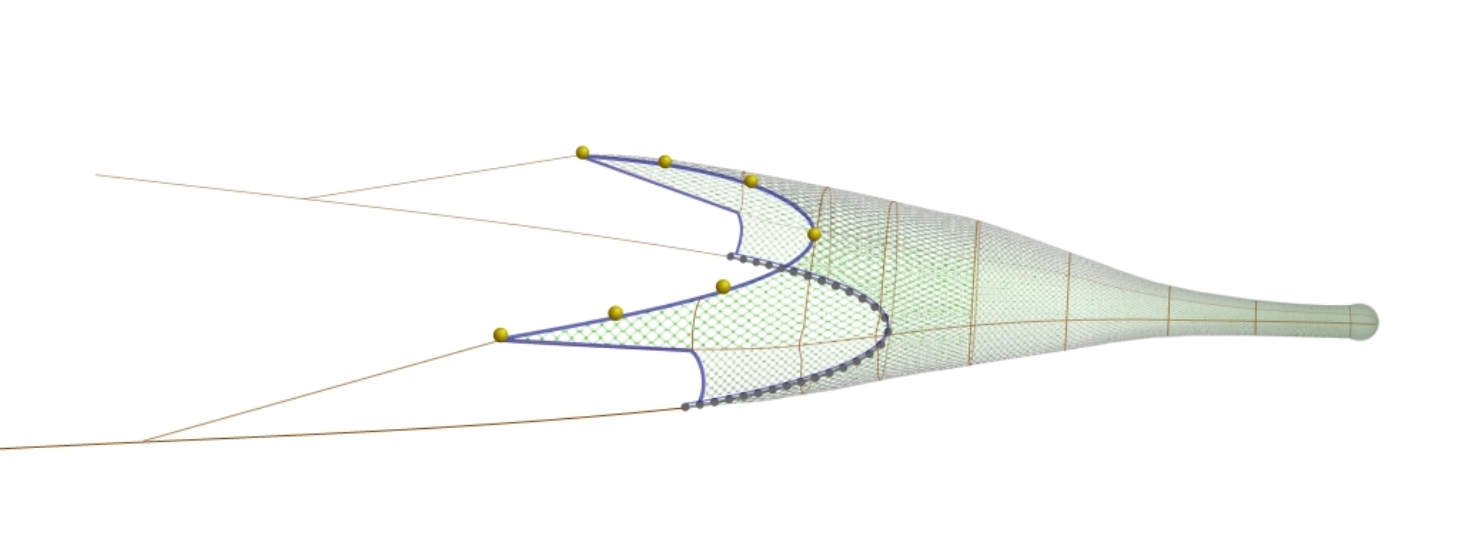Demersal Trawl - Rockhopper trawl
Alternative names
-
- Hopper Trawl
Summary
The rockhopper or hopper trawl, as it is commonly known as, is a trawl that is towed on the seabed, with the mouth held open by a pair of otter boards (trawl doors). It is designed to be towed over hard, rough seabeds and rigged with a rock hopper footrope to minimise damage when being towed over these seabeds.

Environmental impact
Generally hopper trawls use larger mesh sizes that release many of the smaller fish very soon in the capture process. This large mesh will get gradually smaller the further back in the trawl until the cod-end that is often the minimum regulation mesh size. Hopper trawls are usually designed so that the netting panels are well clear of the sea bed and meshes well open to allow any benthic debris and small fish to escape easily.
With larger mesh sizes and sections of different mesh orientation (T90, square mesh) this gear can be made very effective at preventing release of smaller fish of all species. Many skippers are voluntarily using larger mesh sizes in the cod-end to minimise capture of small fish that they will have to discard. However as the gear can be towed over a range of seabed types it has the potential to target several different species, often during the same towing operation, this can create problems with species selectivity, possibly leading to problems with quota allocation.
Seabed impact
As with all trawls there will be a certain degree of seabed impact with the trawl doors. When used properly the weight of any trawl door on the seabed will be much reduced compared to its weight on land. In most demersal trawl fisheries the weight of the trawl door on the seabed will be approximately 20-25% of its weight in air. This is due to several factors. One is about an 8 -10% reduction due to the weight of steel and other materials in water. The other major factor is the tension of the gear behind the trawl door and the uplift from the warp towing the trawl door.
The ground gear on a hopper trawl is made up of large rubber discs spaced out using smaller rubber discs between them with it all threaded onto either wire or chain. Although this can look very heavy and cumbersome, it is quite light on the seabed due to the low density of the rubber and canvas in the rubber hopper discs. The gear is designed to 'bounce' easily over the hard rough ground. The seabed impact of the net and ground gear will be minimised.
Other information
The hopper net is so called because of the rock hopper ground gear generally used with this style of trawl. It is the modern version of the original bobbin gear used by the deep water trawlers in the fifties and sixties. This ground gear is made up of large rubber discs, up to 600mm diameter that are cut from earthmover tyres.
Theses are threaded onto heavy wire or chain, with smaller rubber discs used to space them out. The discs are attached, tied to the fishing line on the bottom of the trawl by light rope, through a hole in the top of the disc.
This rig can look very heavy and cumbersome on the quay, but it will lose about 80% of its weight once immersed in seawater, and actually, it will be quite light on the seabed to allow it to ‘hop’ over the hard rocky seabed, thereby preventing the relatively fragile net from too much damage on the rocky sea bed.
This net is a modified two panel trawl specifically tailored by redesigning the lower panels and fitting the rock hopper ground gear to minimise damage when towing over hard, rough seabeds. Sweeps and bridles are used with this trawl to herd the fish into the trawl although the length of these is usually reduced to minimise the chances of them hooking up on seabed obstructions
Gear classification
Main target species (UK)
-
- Cod
- Dab
- Haddock
- Lemon Sole
- Nephrops
- Pollack (Lythe)
- Round Fish
- Whiting
Possible bycatch
-
- Any demersal species
- Conger Eel
- Cuttlefish
- Dab
- Dogfish
- Flounder
- Flats
- Gurnard
- Haddock
- Hake
- Halibut
- John Dory
- Lemon sole
- Ling
- Megrims
- Monkfish
- Nephrops
- Plaice
- Pollock (Lythe)
- Pouting
- Rays
- Round fish
- Saithe
- Skates
- Squid
- Turbot
- Whiting